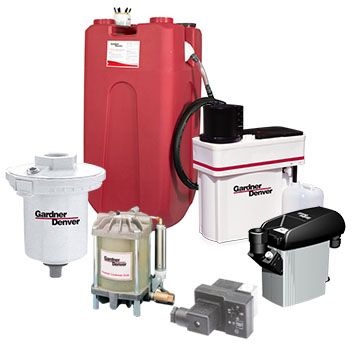
The reality of oil carryover is that it occurs in any compressed air application where the compression occurs in an oil flooded chamber. To truly eliminate oil carryover, an oil free air compressor would need to be used. These systems are less common and often more costly, so the challenge becomes how to control oil carryover as much as possible. The reason is to protect your downstream systems and products from damage or contamination. There are really two methods for combating oil carryover: lessen the amount of oil leaving your air compressor and use air treatment devices such as oil/water separators emplaced downstream from your air compressor to remove trace elements. In this blog we’ll focus on the first method; simply lessening the amount of oil leaving your air compressor.
Causes of excessive Oil Carryover
There are several possible causes for excessive oil carryover. One of the simplest to identify however is actually human error – overfilling the oil reservoir. Most oil reservoirs will have a gauge on them indicating the oil level in the tank. When a compressor is running, this gauge will often show low oil, but this is because the oil is currently cycling in the compressor. Oil level should be checked while the machine is off before making the decision to add more oil to the compressor. This issue comes up much more than you might think! If you have questions, call ESA’s service line and ask one of their certified technicians.
Improper operating temperature is another possible cause. Rotary screw air compressors, for instance, like to run about 100 degrees over ambient temperatures, which averages at around 180 to 190 degrees. A machine that is running cool will not function correctly at the separator and oil will be passed through the separator instead of being removed from the air and returned to the oil reservoir. If the compressor is running at an ideal temperature of 175 – 200 degrees, the water boils off during the process and the air/oil separator functions as it should.
The air/oil separator itself should also be inspected when diagnosing excessive oil carryover. These components should always be a part of a good Preventive Maintenance Plan. Without regularly scheduled replacement of the separator, it can become saturated with oil which will actually make the oil carryover worse and could lead to the separator collapsing and plant down time. The separator is also responsible for cycling the oil back to the oil reservoir. When this system is obstructed, the separator collects the oil and passes it downstream.
Finally, the oil itself should be considered if you are having problems with oil in your air. As oil degrades, its viscosity changes and it is no longer doing what it needs to do to support healthy operations. Water in your oil can have negative effects on both lubrication and the operation of the separator. The oil and water try to separate from each other, saturating the separator with moisture and passing the oil downstream. ESA offers a low-cost oil sample program that affords our customers the ability to have a professional analyze their oil and send them a detailed report of the expected life span of the oil, any contaminants found and other useful information.
How Oil Carryover Affects Your Plant
Although it stems from different sources, oil carryover in your plant can cause significant problems. For starters, oil carryover can become expensive if you are continually filling the oil reservoir. It can also cause contamination in both your air and your products. Finally, excessive oil can damage your production equipment as these systems are not designed to handle oil being passed through their air lines.
Arthur Pue
Arthur Pue is the President of Engineering Sales Associates. Connect with him on LinkedIn.
